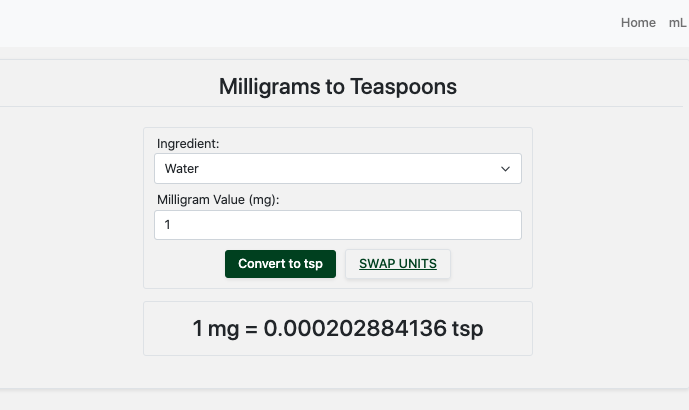Introduction
In the realm of measurement conversions, converting milligrams to teaspoons is a common task encountered in various fields, including cooking, medicine, and nutrition. Understanding how to make this conversion is valuable, as it allows you to accurately measure and administer substances like medication or ingredients in recipes. In this article, we will explore the relationship between milligrams and teaspoons, the factors affecting the conversion, and provide practical examples for a better understanding.
Understanding the Basics
Before delving into specific conversion factors, it’s essential to grasp the basic principles involved in converting milligrams to teaspoons.
- Milligrams : Milligrams are a unit of mass in the metric system. They are typically used to measure the weight of small quantities of substances, such as medication or certain food additives.
- Teaspoons : Teaspoons, on the other hand, are a unit of volume used in culinary and household measurements. They are often used to quantify ingredients like sugar, salt, or spices.
The key challenge in converting between these units is that milligrams measure mass (weight), while teaspoons measure volume (capacity). To bridge this gap, we need to consider the density of the substance being measured.
Density Matters
The density of a substance determines how much space (volume) a given mass (weight) of that substance occupies. Different substances have different densities, which means that the conversion factor between milligrams and teaspoons by mg to tsp can vary widely depending on what you’re measuring.
For instance, a teaspoon of sugar will have a different weight (in milligrams) than a teaspoon of salt, even though both teaspoons have the same volume.
The Conversion Factor of mg to tsp
To convert milligrams to teaspoons, you need to know the density of the substance you’re measuring. The general formula for this conversion is:
Teaspoons =Milligrams (mg)Density (mg/tsp)
Teaspoons =
Density (mg/tsp)
Milligrams (mg)
The density value is specific to the substance in question and can vary. For example, the density of granulated sugar is approximately 4,000 mg/tsp, while the density of table salt is around 6,000 mg/tsp.
Practical Examples of mg to tsp
Let’s explore a couple of practical examples to illustrate the conversion process:
Example 1: Converting Medication Dosage
Suppose you have a medication with a recommended dosage of 500 mg, and you need to administer it in teaspoons. If you know the density of this medication is 5,000 mg/tsp, you can use the formula:
Teaspoons =500 mg5,000 mg/tsp=0.1 tsp
Teaspoons =
5,000mg/tsp
500mg
=0.1tsp
So, the dosage is equivalent to 0.1 teaspoon.
Example 2: Baking with Ingredients
In a recipe, you need to add 2,000 mg of vanilla extract, and you want to know how many teaspoons that is. If you know the density of vanilla extract is 2,500 mg/tsp, you can use the formula:
Teaspoons (tsp)=2,000 mg2,500 mg/tsp=0.8 tsp
Teaspoons (tsp)=
2,500mg/tsp
2,000mg
=0.8tsp
Thus, 2,000 mg of vanilla extract is equivalent to 0.8 teaspoons.
Conclusion
Converting milligrams to teaspoons is a valuable skill for a variety of applications, from medication administration to culinary endeavors. Understanding the density of the substance you’re working with is crucial for accurate conversions. Armed with this knowledge and the conversion formula, you can confidently navigate between these two units of measurement, ensuring precision in your daily tasks and activities.
You may also like
-
Solar System with PVblink Inverter: The Future of Renewable Energy
-
Enclosed Auto Transport | Secure & Premium Vehicle Shipping with Titan Auto Logistic
-
7 Key Factors Why Animated Videos Are Essential for Your Business
-
Cayman Insights: Legal Support at Its Best
-
The Role And Responsibilities Of Bail Bond Agents in Fort Worth TX

